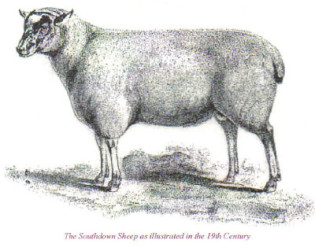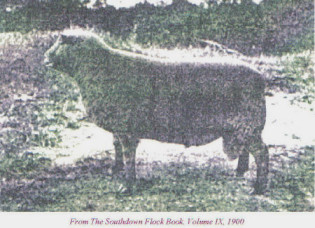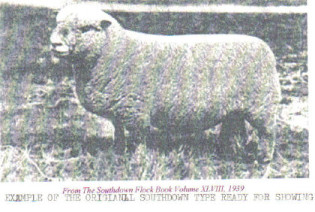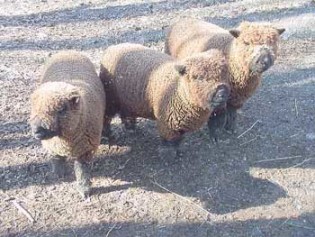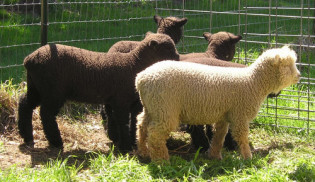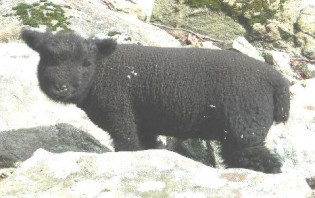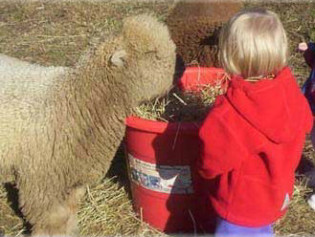About The Breed
Origin and Background
One of the oldest of the English breeds of sheep is the Southdown, originating on the South Down hills of Sussex County, England. These small sheep were know for their extreme hardiness and produced meat with unmatched tenderness and flavor then any other breed of sheep.
In 1780 John Ellman, realized the potential of these animals and set out to standardize the Southdown breed. In England, these small Southdowns grew in popularity up until 1908 when there were approximately 367 registered flocks totaling about 110,000 ewes. The growth in this breed’s development slowed in the early 1900s as World War I brought a sharp decline in their numbers. By the end of the World War II, the demand for larger cuts of meat had almost forced the breed into extinction.
It is believed that the breed reached the United States in 1803. Their popularity grew and later declined in nearly the same pattern that had occurred in England. The small Southdown could not satisfy the consumer demand for larger meat cuts. This was a significant factor in the development and mass production of the larger, leggier Southdown of today. This divergence from the original breed standards was the beginning of what would later become two distinct lines: The Southdown and the miniature (or original) Southdown. In breeding for these larger characteristics however, many of the original “miniature” attributes were bred out and nearly lost. Each year brought a further decline in the number of these “original” Southdowns.
In 1986, Mr. Robert Mock began a search for the sheep with the original blood lines that conformed to the original Southdown of the 1700s. Finding them proved to be difficult. At one point they were believed to be extinct. After a four-year search, two small flocks totaling 26 sheep were located; however, this group would not be able to provide a sustainable gene pool. After further extensive searching, a total of 350 of these miniature sheep were located. Many of them still carried their original Southdown registration papers.
To distinguish these small sheep from the larger modern-era Southdown, Mr. Mock named them “Olde English Babydoll Southdowns.” To keep this line pure, a registry was formed. Only adults two years and older were accepted so that they could be judged against the original conformation standards as verified by a veterinarian. Each sheep’s registration application was passed before a board of three members of the Breed Association. After this initial review and acceptance period, the “Foundation Flock” registry was closed in 1991. The term Foundation Flock is still used to refer to this original pool of sheep. Subsequently, the process of registering lambs from this original foundation flock began. For more history on the Registry, see “15 Years and 7832 Babydolls Later and Still Growing!”
Uses for the “Babydoll” Southdown
Olde English “Babydoll” Southdowns are outstanding pets who produce wool that is a hand spinner’s delight. They provide organic weeding and make excellent companion animals and are also a sound investment opportunity.
Wonderful Pets
These little “Babydoll” sheep make excellent companions for the young, elderly, and disabled. Their gentle nature makes them a joy to own, and their diminutive size makes them an excellent choice for 4-H projects.
Wool
“Babydoll” fleece generally runs in the 19 to 22 micron range, which puts the fleece in the class of cashmere. Babydoll fleece also has more barbs per inch than any other wool type, making it ideal for blending with other fibers.
Gardeners
Weeding trials were sponsored and monitored by the association, utilizing “Babydolls” as organic weeders. They have been used with great success in wine vineyards as well as fruit and berry orchards since they will not harm the fruits, girdle trunks of trees, or harm shrubs. They leave the grounds well groomed and fertilize the soil as they graze.
Companions
“Babydoll” Southdowns are wonderful companion animals for other non-aggressive livestock. Their calm, docile disposition has a soothing effect on other livestock. They should not be kept with intact male llamas or alpacas who may attempt breeding with them. It is wise to introduce them gradually to other livestock by putting them in separate paddocks when they first arrive to their new home. This give their new friends an opportunity to say hi without it being overwhelming to the Babydoll sheep.
Care
“Babydolls” require the same care as other sheep breeds such as hoof trimming, worming, vaccinations, and yearly shearing. The handling facilities and feed are not as costly as with larger breeds. Shelter can be minimal, except at lambing time. Good fences are essential, more for protection from predators than containment since Babydolls do not challenge fences and do not wonder far. Portable electric mesh fences are great if you do not already have permanent fencing.
Feed, salt and mineral blocks are important for good health but you must make sure you do not give any sheep copper. Any feed, salt or mineral block that has copper in it must be keep out of reach of any sheep.
Why Everyone Loves Their “Babydoll” Southdowns
The “Babydoll” woolly teddy bear face will always give you a smile. Their short legs along with their small size allows them the ability to do well in small areas. They are ideal for suburban lot owners who want the tranquility of sheep as living lawn ornaments. Both ewes and rams are polled (have no horns) and are non-aggressive by nature. The ewes are very good mothers, often raising twins and triplets with ease.
Because “Babydoll” Southdowns are a ancient breed, they are not prone to many of the modern sheep problems and are resistant to foot rot. In general, they are cared for like any other sheep which includes worming, hoof trimming, shearing, and vaccination.
Returned To Their Homeland
One of the major goals of the original “Babydoll” Southdown Registry (Olde English “Babydoll” Southdown Sheep Registry) was to return the original breed to England where the little sheep had been extinct for over 50 years. This goal was accomplished in 1999, but their numbers are so few that they remain on the Rare Breeds Survival Trust List (RBST) www.rbst.org.uk
One Important Note
Because of their strong flocking instinct “Babydolls” do not do well as singles. They thrive on companionship and must be with their own kind or another breed of sheep or goat. Due to this fact, lambs should only be sold in pairs if the buyer does not already have companions for their lamb.
